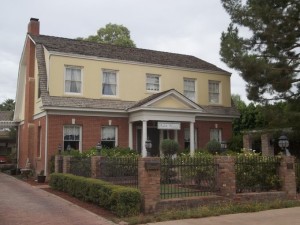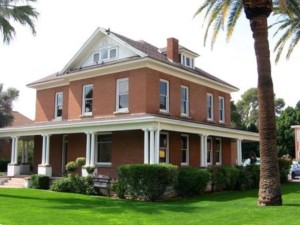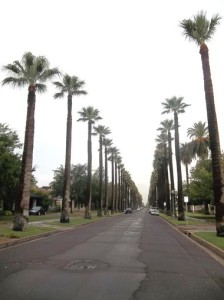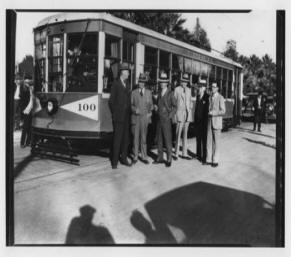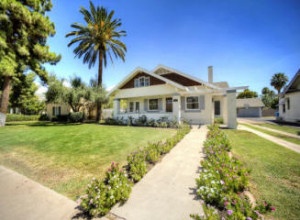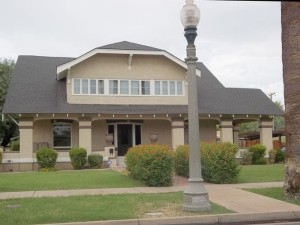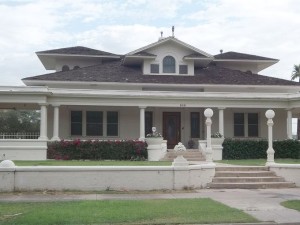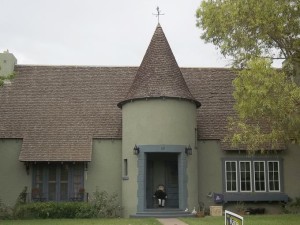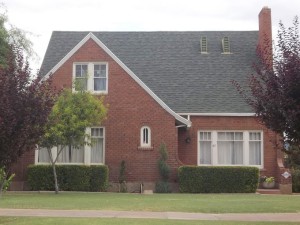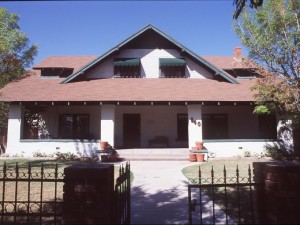The History of Roosevelt Historic District in Phoenix Arizona
Roosevelt Historic District History spans the years 1893 to 1930. It has several factors early on in Phoenix accounting for the development of the area.
Highlights of Significance In Roosevelt Historic District:
- Location: Roughly bounded by Portland and Fillmore Streets., Central and 7th Avenues., Phoenix (480 acres, 92 buildings)
- Historic Significance: Event, Architecture/Engineering, Person
- Architects, Builders and Engineers: Multiple – Read Article
- Architectural Styles: Late 19th And 20th Century Period Revivals, Bungalow/Craftsman, Mission Revival, Prairie School Styles, Other
- Historical Persons: Multiple – Read Article
- Significant Years: 1897 and 1937
- Areas of Significance: Community Planning And Development, Architecture
- Periods of Significance: 1875-1899, 1900-1924, 1925-1949
- Historic Function: Domestic
- Historic Sub-Function: Multiple Dwelling, Single Dwelling
- Current Function: Commerce/Trade, Domestic, Landscape, Religion
- Current Sub-Function: Multiple Dwelling, Park, Single Dwelling
A Mixed Use District
Roosevelt Row has been a vital mixed use area from the earliest days of the establishment of Phoenix. Many of the concrete sidewalks in the neighborhood were poured in 1909, three years before Arizona officially became the 48th State.
Businesses Established Along Roosevelt Street
In the early 1940’s, Roosevelt Historic District history states there were approximately 30,000 people living in Phoenix. And, numerous businesses were established along Roosevelt Street. The flower shop at Fifth Street and Roosevelt has been in continuous operation since 1948.
1970’s Rezoning
In the 1970’s, parts of the area were re-zoned as a high-rise incentive district leading to land speculation and a decline of the neighborhood that lasted until the late 1990’s.
Calling All Artists
The blighted area was attractive to artists because the boarded-up buildings and former crack houses were affordable for studio and gallery space. The arts were a major factor in the revitalization of the area and crime rates plummeted as more people began to venture into the area to experience the cultural vibrancy.
Roosevelt Historic District Early Influences
Several factors in the early history of Phoenix account for the development of the area now known as the Roosevelt Neighborhood. From its founding in 1867, Phoenix experienced slow, but steady outward growth.
Completing the Connection to the Transcontinental Railroad in 1884
The completion of a connection to the transcontinental railroad in 1884 brought hundreds of new residents and visitors to the Valley. Construction materials such as wood, glass, stone and prefabricated components became available to local builders who soon began to discard the use of adobe and other native materials in an effort to create a city that resembled the rest of the country.
Flooding of the Salt River in 1890 and 1891
Initially, many prominent residents constructed houses in the southern and eastern portions of the original Phoenix town site. However, severe flooding of the Salt River in 1890 and 1891 caused the more wealthy residents to move north to higher ground along Center Street (now Central Avenue), west along Washington Street and adjacent to the Grand Avenue diagonal. This northward movement altered the growth pattern of Phoenix and accounts for the development of the Roosevelt Neighborhood.
Expansion of Roosevelt Neighborhood 1893 to 1930
Expansion of the city into the Roosevelt Historic District spans the years 1893 to 1930. The neighborhood developed through the construction of nine distinct additions:
- Kenilworth and Bennett Place each contained well over 200 lots
- Planks Addition had just ten
- McDowell Place, fourteen
- The other five (Simms Addition, Bennett and Plank’s Addition, Chester Place, Chelsea Place and the Blount Addition to Chelsea Place) ranged from 26 to 134 lots
Many of the city’s elite, the pioneers who helped shape Phoenix during its infancy, made their homes in this neighborhood.
The Portland Street Development In Roosevelt Historic District
The Portland Street historic area was developed between 1911 and 1927 and exhibits an aura of early twentieth century grandeur unique in the City of Phoenix.
Portland Street is Part of the Original Kenilworth Subdivision
This area is actually part of the original Kenilworth Subdivision. It contains 35 large houses in the Bungalow and Period Revival idioms (32 of which are historic). The houses are sited on spacious lots with a landscaped right-of-way giving the illusion of a setback deeper than the actual 20 feet and providing a graceful ambiance. A significant visual element is the rows of California fan palm trees, which line the street today as they did during the period of significance (1911-1930).
“Streetcar Suburb” called The Kenilworth Line
Roosevelt was originally developed as a “streetcar suburb”. The Kenilworth Line, financed by the subdivision’s early developers, the Hartranft-Tweed Company, ran from its origin at 2nd Avenue and Washington Street, up 5th Avenue to its terminus just north of McDowell Road.
The Streetcar and the Central Business District
The streetcar made the addition easily accessible to the central business district, an amenity that was heavily promoted in advertisements for the residential tract. Early development in the Kenilworth Addition focused on Portland Street, which quickly became a showcase neighborhood and home for many of the City’s leaders. The district is also notable for its outstanding assemblage of architecture, including Bungalows and houses designed in the Italian Villa, Mission Revival, Spanish Colonial Revival, and Prairie School styles.
Simms Addition History In Roosevelt
Colonel J.T. Simms came to Arizona in 1881 as a contractor with the Atlantic and Pacific Railroad Company. After building the Arizona Canal with W.J. Murphy between 1883 and 1884, Simms retired to run his ranch and manage his real estate interests.
Simms Files Large Land Plat
Several years later, some land Simms owned was surveyed and on June 26, 1893, a plat was filed for the area bounded by Central Avenue, Roosevelt, Third Avenue, and Moreland. Simms himself later lived in the area at 1008 North Central. He left Phoenix in 1896 after a sordid divorce and died in Chicago in 1898. Despite the rampant land speculation in Phoenix at the turn-of-the-century, building in the Simms Addition progressed slowly.
Center Street and the Business District In Roosevelt
Central Avenue, then known as Center Street, was the primary thoroughfare to the business district, and lots along this street were deemed prime residential locations. By 1901, residences fronting Central Avenue had been constructed on all but two lots.
Phoenix Early Prominent Citizens:
- In addition to Simms and Melczer, resided the upper crust of Phoenix’ early citizens:
- Charles H. Akers, Secretary of the Territory of Arizona
- C.M. Frazier, a prominent attorney who would go on to become Attorney General
- Frank R. Cleary, Chairman of the Arizona Water Company
- Lloyd B. Christy, Chairman of the Valley Bank of Phoenix
- Ezra W. Thayer, owner of Thayer’s Hardware Store.
Slow Growth Until the Booming 1930s
Despite annexation and the elite status of the area, growth in the balance of the Simms Addition averaged only one home per year until 1920. Then, as history world have it, during the booming twenties, all remaining lots but one were developed.
Prominent Businessmen Call Roosevelt Home
The number of prominent businessmen, lawyers, doctors and city officials making their homes in the addition continued to increase. Among them was Richard E. Sloan, Governor of the Territory of Arizona from 1909 to 1912.
The Birth of Bennett Place In Roosevelt
Guy Bennett was a cattle dealer and real estate speculator who moved to Phoenix from Missouri in about 1884. The area known as Bennett Place, bounded roughly by West Roosevelt and West Fillmore on the north and south, and by Central and Fifth Avenues on the east and west, was platted by Guy and Sadie Bennett in December 1894.
Many Lots, Slow Growth in Bennett Place
While not geographically the largest of the Roosevelt Neighborhood’s nine additions, Bennett Place had the greatest number of lots, 276. Development in Bennett Place was slow, but steady.
City Council Considers an Annex
During the 1890’s, the city council embarked on a campaign to annex the area’s increasingly populated northern additions. The residents of Bennett Place were resistant. They felt that additional city taxes would be put to use in other areas of the city, rather than benefiting their neighborhood.
Bennett Place Gets Annexed
The city council was forced to take a series of court actions against the neighborhood. In 1901, the District Court ruled that Bennett Place would be annexed, but would be exempt from city taxes for a period of two years. In turn, however, the city was relieved of any obligation to extend municipal services to the area during that period.
The Elite Are Still Attracted
As with Simms Addition, the lots along Central and First Avenues attracted the elite of the city, including Carl Hayden, Arizona’s first U.S. Congressman; and Baron M. Goldwater, Manager of Goldwater’s Mercantile and father of future Senator Barry Goldwater.
The Attraction of Blue Collar Workers
By 1913, history in the making continues with growth within the Addition slowing considerably. During the 1920’s, developers constructed a number of duplexes and apartments in the area hoping to attract a portion of Phoenix’s large number of winter visitors and booming tourist trade. Instead, seizing their chance to live in a more affluent area, an increasing number of blue-collar and middle-class workers made their homes in these new rental properties.
Plank’s Addition
First platted by Levi L. Plank in 1901, this small addition consisted of only ten lots along West McKinley between Fifth and Sixth Avenues. No development occurred in Plank’s Addition until the 1910 extension of the streetcar line along Fifth Avenue. Still, it wasn’t until 1929 that all ten lots were finally developed. The residents were entirely blue-collar workers who lived in bungalows or duplexes.
Bennett and Plank’s Addition
McKinley and Fillmore Streets bound this plat, originally part of the two earlier additions, on the north and south, and by Sixth and Seventh Avenues on the east and west. This land was purchased by four families (the Bennetts’ the Shoffs’ the Peters, and Margaret B. Barringer) who jointly had the area replatted and recorded in November 1910. As late as 1930, less than half of the 34 lots were developed. Most residents of Bennett and Plank’s Addition were blue-collar workers who rented, rather than owned, their homes.
Kenilworth Addition History
The 80-acre area bounded by West McDowell, Third Avenue, West Roosevelt and Seventh Avenue, was known as the Hubbard Tract until February 1910, when A.G. Hubbard sold the land to developer H.I. Latham. Two weeks later, Latham sold the property to the Hartranft-Tweed Real Estate Company, which filed the plat for the Addition in December. In February 1911, Kenilworth was annexed into the City of Phoenix.
Kenilworth developed into an exclusive residential area due to three major influences:
- The extension of the Phoenix Railway streetcar line north along Fifth Avenue through the Addition
- A vigorous advertising campaign, which went so far as to state that “the air is better in Kenilworth”
- The construction of Kenilworth School in 1920
The Fifth Avenue Streetcar Extension
The now historic streetcar made the area very accessible and initial development in Kenilworth was concentrated along the Fifth Avenue streetcar extension. Palm trees were planted along the streets, which were graded, lined with caliche and featured cement sidewalks. Many prominent residents, such as Supreme Court Justice Donald L. Cunningham, Phoenix National Bank President M.C. McDougall, and J.A.R. Irvine, member of the first State Legislature, made their homes in the area.
Building Restrictions During WWI
Building restrictions during WWI slowed growth in the addition between 1916 and 1920. During the decade that followed, the opening of Kenilworth School and a new concept of low down payments and low monthly installments offered by Home Builders, the primary developer, attracted young families to the area. Rapid growth ensued and the Addition’s 228 lots were completely built up by 1938.
History of McDowell Place Plat In Roosevelt
T.M. Burroughs filed the plat for the area encompassing the south side of West McDowell between Central and Third Avenues on January 31, 1910. Despite the small size of the area (which contained just fourteen lots), it was not completely developed until 1930.
The Historic English Cottage Revival Built for Helen Anderson
Roosevelt’s most spectacular residence was an English Cottage Revival built for Helen Anderson, widow of insurance company organizer Carl H. Anderson, at 149 West McDowell Road. In 1923, the Arizona Republican described the house as one of the city’s most beautiful homes. Fortunately, this house remains intact today at its original address, while most of the other original buildings in McDowell Place have been altered as they have been converted for commercial purposes.
Roosevelt’s Chester Place History
Platted in 1909 by the Elliot Evans Company, Chester Place consists of 52 lots on two blocks bounded by West Roosevelt and West McKinley on the north and south, and by Fifth and Seventh Avenues on the east and west. Development of this Addition proceeded somewhat more rapidly than the others in the Roosevelt Neighborhood, being completed by 1930. Chester Place was a very affluent area whose residents included doctors, lawyers and businessmen.
More Chelsea Place History In Roosevelt
This relatively small parcel, spanning West Lynwood and West Willetta between Central and Third Avenues, was annexed to the city in 1913. H.F. Latham, a Phoenix Promoter and owner of a real estate firm, purchased the land from the estate of William E. Thorne on May 20, 1907, and filed a plat the following July. Eight lots known as Latham Place, between Central and Third Avenues, sold within two days without any advertisement whatsoever. The remainder of the tract was resurveyed into 84 lots and development began in 1912.
Chelsea Place Historical Print Media Attention
Chelsea Place was hailed by the Arizona Republican as “the most expensive and artistic development yet attempted in Phoenix.” To enhance its aura of exclusiveness, elaborate street entrances patterned after Los Angeles’ exclusive Lafayette Square were constructed. Made of cast concrete to simulate dressed sandstone, these gateways unfortunately no longer exist.
Chelsea Place Promoted to Attract Affluent Residents
Chelsea Place was promoted as a showplace residential development and attracted many affluent residents. However, Home Builders, the primary developer, sold homes on an installment plan with a low down payment, bringing home ownership within reach of the less affluent as well.
Blount Addition History In Roosevelt
Platted in March 1919, by Frank J. Blount and W.C. Ellis as the Blount Addition to Chelsea Place, the Addition spans both sides of West Culver Street between Central and Third Avenues. Frank Blount was a rancher who had lived on the property facing Central Avenue since 1908. William Ellis was a successful physician and surgeon who founded Deaconess Hospital (later to be renamed Good Samaritan Hospital) and served one term as City Commissioner from 1920-1921. His house is at 1242 North Central.
Development in the Addition proceeded slowly, with eight of the 40 lots still unoccupied by 1930. Its residents were mostly white-collar professionals, although the area was not known for the elitism of Chelsea Place or Kenilworth.
Neighborhood Architecture Defines Roosevelt History
As was typical of a streetcar suburb, most of Roosevelt’s lots are narrow and deep, minimizing the distance residents must walk to reach transportation. In contrast to the monotony of modern tract neighborhoods, the diversity of housing styles in Phoenix’ historic districts gives each a distinctive flavor. Architecturally, the Roosevelt Neighborhood has some of the finest examples of early twentieth century residential architecture in Phoenix.
The California Bungalow
The most common building type in the area is the California Bungalow, which dominates most of the district’s streetscape. Among these relatively plain homes also are found many finely detailed Craftsman Bungalows and Period Revival houses.
What Are the Features of a California Bungalow?
A Bungalow is typically a one-story house with a simple, functional floor plan and one or more broadly pitched roof gables with deep overhangs. Broad front porches with massive square porch columns are an essential feature. Bungalows are the most common type of Craftsman influenced architecture.
The Craftsman Movement In Roosevelt’s History
The Craftsman movement, a popular building philosophy of the early twentieth century, used natural and rustic materials. It stressed comfort, utility and convenience as well as high quality workmanship in design and construction. So-called Craftsman Bungalows were usually covered with natural wood shingles and had foundations, porch columns and chimneys of stone, rough-faced brick or textured concrete.
Roosevelt Historical Neighborhood Includes Outstanding Examples of Public Buildings:
- The Trinity Cathedral, Kenilworth School
- The Westward Ho Hotel
- The Gold Spot Marketing Center was built by developers to serve Winter visitors and is one of the first shopping centers in Phoenix built for a specific residential area
The construction marked the beginning of a trend toward small neighborhood centers away from the original central Phoenix commercial district.
Roosevelt Neighborhood’s Significance to Phoenix
As with the other Phoenix historic districts in the City, the development of the Roosevelt Neighborhood provides physical expression of the early growth of Phoenix. Within it are buildings, which are both historically and architecturally important because they represent many important milestones in the evolution of our present community.
The Rise of an Affluent “Streetcar Suburb”
From its rise as an affluent “streetcar suburb,” to its development associated with early tourism, to its designation as the first historic district in Phoenix, the Roosevelt Neighborhood continues to play a significant role in the history of Phoenix. As an intact collection of early twentieth century architecture, it contributes to the visual diversity and character of the historic heart of our community.
Historic Districts Near Roosevelt
If you like Roosevelt Historic District, you”ll most definitely want to cruise on over to Willo Historic District and Encanto-Palmcroft Historic District as well. They’re simply gorgeous neighborhoods and give you the flashbacks of grandma’s house. Also check out the wonderful Shopping and Dining in and around the Roosevelt Historic District in Phoenix Arizona.
Historical Information provided courtesy: Historic Preservation Office of the City of Phoenix Neighborhood Services Department and Special Planning District 200 West Washington Street Phoenix, Arizona 85003 (602) 261-8699
